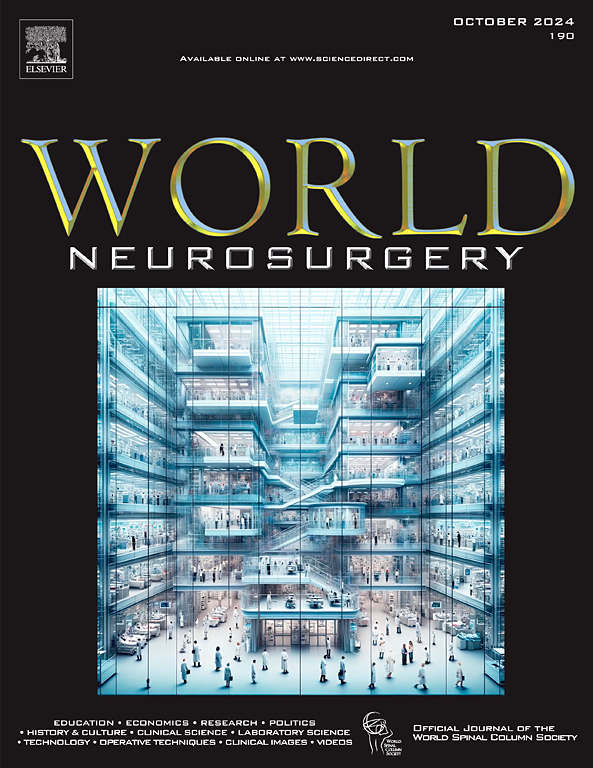Surpass Streamline Flow Diverter for the Treatment of Craniocervical Unruptured Dissecting Aneurysms: A Multi-Institutional Retrospective Study
IF 1.9
4区 医学
Q3 CLINICAL NEUROLOGY
引用次数: 0
Abstract
Objective
Currently, there is no established treatment consensus for craniocervical unruptured dissecting aneurysms (UDAs). This study aimed to assess the safety and efficacy of the Surpass Streamline Flow Diverter (SSFD) for treating craniocervical UDAs.
Methods
A retrospective review of 3 centers’ databases was conducted to identify patients with craniocervical UDAs treated with SSFDs from January 2021 to December 2023. Data, including patient and aneurysm characteristics, procedure details, imaging findings, and follow-up data were analyzed.
Results
The study included 35 patients with 35 craniocervical UDAs. The mean maximal length of the UDAs was 13.0 ± 6.0 mm, with 57% ranging from 10 to 25 mm. At a mean follow-up of 8.7 ± 2.5 months, the complete occlusion rate was 71% (25/35), with no recurrences detected. Perioperative complications occurred in 3 patients (9%), comprising ischemic stroke in 2 patients (6%) and hemorrhagic stroke in 1 patient (3%). All patients had a good clinical outcome at the 6-month follow-up (modified Rankin Scale <3). Multivariate logistic regression analysis revealed that aneurysmal dilation with stenosis (odds ratio = 0.034, 95% confidence interval: 0.001–0.845; P = 0.04) was a significant predictive factor for incomplete occlusion of treated aneurysms.
Conclusions
Our findings suggest that SSFD is a safe and effective tool for craniocervical UDAs, demonstrating a high occlusion rate, acceptable complication rate, and good clinical outcome.
超流线分流器治疗颅颈部未破裂夹层动脉瘤:一项多机构回顾性研究。
目的:目前,颅颈部未破裂夹层动脉瘤(UDAs)的治疗尚无既定的共识。本研究旨在评估超流线分流器(SSFD)治疗颅颈UDAs的安全性和有效性。方法:对三个中心的数据库进行回顾性分析,以确定2021年1月至2023年12月期间接受ssfd治疗的颅颈UDAs患者。数据包括患者和动脉瘤特征、手术细节、影像学表现和随访数据。结果:本研究纳入35例颅颈UDAs。UDAs的平均最大长度为13.0±6.0 mm, 57%的UDAs长度在10 ~ 25mm之间。平均随访8.7±2.5个月,完全闭塞率71%(25/35),无复发。围手术期并发症3例(9%),其中缺血性卒中2例(6%),出血性卒中1例(3%)。随访6个月,所有患者临床预后良好(mRS < 3)。多因素logistic回归分析显示,动脉瘤扩张合并狭窄(OR=0.034, 95% CI: 0.001 - 0.845;P =0.04)是治疗后动脉瘤不完全闭塞的重要预测因素。结论:我们的研究结果表明,SSFD是一种安全有效的治疗颅颈UDAs的工具,具有高的闭塞率,可接受的并发症发生率和良好的临床结果。
本文章由计算机程序翻译,如有差异,请以英文原文为准。
求助全文
约1分钟内获得全文
求助全文
来源期刊

World neurosurgery
CLINICAL NEUROLOGY-SURGERY
CiteScore
3.90
自引率
15.00%
发文量
1765
审稿时长
47 days
期刊介绍:
World Neurosurgery has an open access mirror journal World Neurosurgery: X, sharing the same aims and scope, editorial team, submission system and rigorous peer review.
The journal''s mission is to:
-To provide a first-class international forum and a 2-way conduit for dialogue that is relevant to neurosurgeons and providers who care for neurosurgery patients. The categories of the exchanged information include clinical and basic science, as well as global information that provide social, political, educational, economic, cultural or societal insights and knowledge that are of significance and relevance to worldwide neurosurgery patient care.
-To act as a primary intellectual catalyst for the stimulation of creativity, the creation of new knowledge, and the enhancement of quality neurosurgical care worldwide.
-To provide a forum for communication that enriches the lives of all neurosurgeons and their colleagues; and, in so doing, enriches the lives of their patients.
Topics to be addressed in World Neurosurgery include: EDUCATION, ECONOMICS, RESEARCH, POLITICS, HISTORY, CULTURE, CLINICAL SCIENCE, LABORATORY SCIENCE, TECHNOLOGY, OPERATIVE TECHNIQUES, CLINICAL IMAGES, VIDEOS
 求助内容:
求助内容: 应助结果提醒方式:
应助结果提醒方式:


